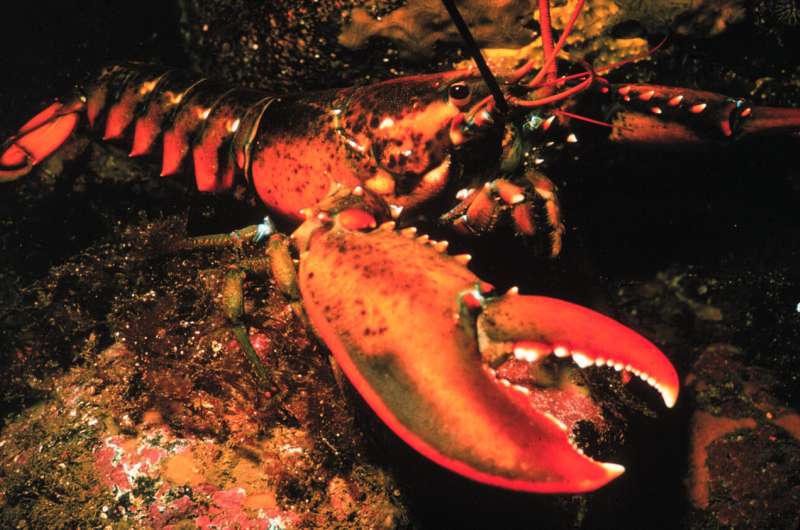Study shows that lobsters can detect sound, and raises concern about impact of anthropogenic noise

A new study demonstrates that lobsters can detect low-frequency sound and suggests that anthropogenic noise could affect lobsters. The study comes out at a time when the construction of more offshore wind farms, with their associated underwater pile driving noise, is being considered in New England.
The paper, "Sound detection by the American lobster (Homarus americanus)," found that hairfans—external cuticular hairs that cover much of lobster bodies—likely are responsible for the crustacean's sound detection and implies that hearing is "mechanistically possible in a wider array of marine invertebrates than previously considered."
This is the first study demonstrating sound detection in the American lobster using what's known as auditory evoked potential (AEP) methods, which use electrodes placed near the brain of the animal to detect neuron responses to sounds.
"We found that the lobsters' frequency of sound detection overlaps the frequency of the buzzing sounds that they produce. This means that lobsters are clearly capable of communicating with these buzzing sounds while engaged in important behavior such as during aggressive encounters between males, which are crucial confrontations during reproduction," said Youenn Jézéquel, a postdoctoral researcher at the Woods Hole Oceanographic Institution (WHOI), who is the lead author of the paper.
Jézéquel said this "raises clear concerns" about the potential impact of anthropogenic noise on these lobsters because anthropogenic noise overlaps with the frequency range of lobster sound detection, which is in the range of 100-200 hertz.
"This study is a preliminary step to understanding the impact of anthropogenic noise on lobster behavior," he said. "We need marine renewable energy, but we don't want to impact marine life. It's very important to assess the impact of pile driving noise on lobster populations to be able to tell fishermen, politicians, and others about these impacts and to try to reduce sounds produced by offshore wind farms as much as we can." Among anthropogenic noise sources, pile driving is a major concern because of the high intensity of sound that it releases underwater.
It's important to assess the noise impact because the American lobster fishery, which extends from Maine to North Carolina, is the most valuable single-species fishery in the United States, according to the National Oceanic and Atmospheric Administration (NOAA). Commercial landings of American lobster in 2019 totaled more than 125.8 million pounds and were valued at more than $628.5 million, according to NOAA. Lobster fisherman and supporters have expressed concern about proposed wind farms off the coast of Maine.
While scientists have known for decades that marine mammals and fish use sounds to communicate with members of their same species, there is comparatively much less data on sound detection among aquatic invertebrates.
To determine which lobster sensory organ is responsible for sound detection, researchers examined several possibilities, including hairfans and statocysts, the latter of which are located in the basal segment of each antenna in the head of the crustacean.
They ruled out statocysts because the study found no significant differences in sound detection with our without lobster antennas surgically removed. However, the researchers found that lobsters with immobilized hairfans "had highly reduced or extinguished AEP responses. This suggests that [hairfans] play a key role in sound detection," the study noted. Researchers temporarily immobilized hairfans by covering lobster bodies with a lacquer spray.
For their study, which was conducted at WHOI in February and March 2020, researchers used 16 adult lobsters, a standard sample size for AEP studies of marine invertebrates. They suspended the lobsters in an opaque plastic tank and used a small underwater speaker to play sounds at different frequencies. Jézéquel said that in future studies, he would like to expose lobsters to different sources of anthropogenic noise, including shipping and pile driving noise.
Jézéquel, who grew up near the seashore in Brittany in northwestern France, said that lobsters have fascinated him ever since he was a child. "They are the kings of crustaceans," he said.
"What we all hope to discover is that anthropogenic noise would not have much impact on the life cycle of lobsters," he said. "However, we are not sure yet, considering the impact that has been shown on marine mammals and fish."
More information: Youenn Jézéquel et al, Sound detection by the American lobster (Homarus americanus), Journal of Experimental Biology (2021). DOI: 10.1242/jeb.240747
Journal information: Journal of Experimental Biology
Provided by Woods Hole Oceanographic Institution


















